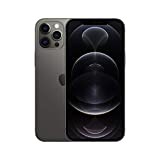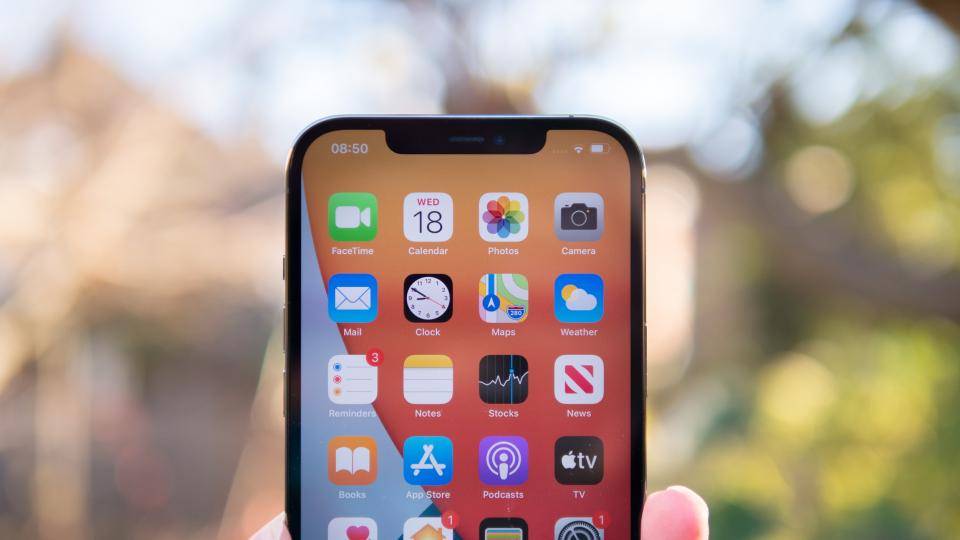As the occasional reviewer of smartphones, I’ve become accustomed to testing out big handsets like the Apple iPhone 12 Pro Max. Most flagship phones are pretty beefy these days and it’s possible to get used to anything given time. At 6.7in, however, the iPhone 12 Pro Max is an absolute behemoth. It’s larger than the 11 Pro Max I’ve been using for most of 2020 and feels like one of the biggest phones I’ve ever had in my pocket.
If I’m honest, I prefer the smaller size of the iPhone 12 Pro . It’s simply more practical: lighter, easier to slip in and out of a jeans pocket and I feel less like I’m going to drop it every time I use it. I’m torn, however, because this, in most other respects, is the very best phone that Apple makes.


Apple iPhone 12 Pro Max review: What you need to know
That’s because, instead of keeping features largely consistent across both the iPhone Pro models, the two are distinctly different this year, and it’s the iPhone 12 Pro Max that gets all the goodies.
Pay attention to the fine details and you’ll discover that, in addition to that enormous 6.7in screen – 0.6in bigger than the 12 Pro – the 12 Pro Max has a superior camera system. Not only does the main camera have a larger sensor but it also has a new type of optical image stabilisation system: sensor shift. Both upgrades improve image quality in all conditions.
READ NEXT: Read our guide to the best smartphones money can buy
The iPhone 12 Pro Max also has slightly more reach in the telephoto lens – it’s a 2.5x zoom rather than the 2x you get on the iPhone 12 Pro – which helps you get closer to your subject and create more flattering portraits.
Otherwise, the iPhone 12 Pro Max is a match for the smaller 12 Pro across the board. It comes in the same four colours – silver, dark grey, gold and blue – uses the same stainless steel frame and ceramic shield glass at the front, and employs the same 5nm A14 Bionic processor.

Apple iPhone 12 Pro Max review: Price and competition
With an increase in size and a superior feature set, it is perhaps inevitable that the Apple iPhone 12 Pro Max is the most expensive of the 2020 iPhones. Given that it’s significantly better than the iPhone 12 Pro, though, the added cost isn’t as much as I’d expected.
Prices start at £1,099 for the iPhone 12 Pro Max with 128GB of storage, which is only £100 more expensive than the smaller 12 Pro. Those prices then rise to £1,199 for the 256GB model and £1,399 for the 512GB variant. As with all iPhones, you can’t expand the storage so choose carefully before splashing out.
Which other phones can you buy for £1,099 that aren’t made by Apple, then? Well, we can’t currently recommend the Huawei P40 Pro or the Mate 40 since the ban on using Google apps and the Play Store is still in place, so that whittles the rivals down to one: the superlative Samsung Galaxy Note 20 Ultra 5G.
At an RRP of £1,179, the Samsung Galaxy Note Ultra is the more impressive handset on paper. It’s a touch cheaper on price than the iPhone 12 Pro Max (when compared with the equivalent 256GB model) plus, it comes with a more powerful 5x optical zoom on the telephoto camera, an even larger 6.9in display and an active S Pen stylus that stows neatly away in the phone’s slim body.
Apple iPhone 12 Pro Max review: Design and key features
There are two big new design changes on the 2020 iPhones and these both carry over to the iPhone 12 Pro Max. First, the edges are now flat instead of curved. This isn’t much of an improvement, per se – the new iPhones are a little easier to grip as a result – but they do still look rather nice.
The bigger change is that the glass on both the front and rear of the phone is tougher than last year’s models. Apple claims, in fact, that the new iPhones are four times more drop resistant than before and, while I’m personally reluctant to test that out, I can tell you that, so far, that the Ceramic Shield glass on the iPhone 12 Pro I’ve been using for a month has yet to show a single scratch.
The bigger test will be long-term use; if the phone can resist scratches for a whole year, then I’ll be seriously impressed because no phone I’ve ever used for an extended period has ever managed to do that. Time will tell, but so far, so good.
Other details will be familiar to most, even to those who don’t own an iPhone. As with the 2019 iPhone 11 Pro models, the 12 Pro Max is finished with a textured, frosted back and has a stainless steel frame that’s polished to a high shine. On the rear, there’s a triple-camera system arranged in a triangle, which is surrounded in turn by a raised square camera bump.
The dark grey, “graphite” model in the photos here looks wonderful and just as good as the blue version of the iPhone 12 Pro I reviewed recently, while the gold model iPhone looks more like the real thing than ever. Such a shame that my paranoia dictates I’ll pop it straight in a case after I finish taking photographs of the thing, though.
The iPhone 12 Pro is slightly bigger than its predecessor, the iPhone 11 Pro Max and the difference is noticeable to a degree that I hadn’t expected, especially given the apparently small 0.2in difference in screen size.
Here’s a quick table comparing the size of the iPhone 12 Pro Max with the iPhone 11 Pro Max, the Samsung Galaxy Note 20 Ultra and the iPhone 11 Pro:
|
Width (mm) |
Thickness (mm) |
Height (mm) |
|
iPhone 12 Pro Max |
78.1 |
7.4 |
160.8 |
|
iPhone 11 Pro Max |
77.8 |
8.1 |
158 |
|
iPhone 12 Pro |
71.5 |
7.4 |
146.7 |
|
Samsung Galaxy Note 20 Ultra 5G |
77.2 |
8.1 |
164.8 |
Width (mm)
Thickness (mm)
Height (mm)
iPhone 12 Pro Max
78.1
7.4
160.8
iPhone 11 Pro Max
77.8
8.1
158
iPhone 12 Pro
71.5
7.4
146.7
Samsung Galaxy Note 20 Ultra 5G
77.2
8.1
164.8
Between the iPhone 12 Pro Max and its predecessor, there’s only 2.8mm when it comes to height and only 0.3mm in the width but, somehow, small margins seem to matter all the more when a phone is already this huge.
Elsewhere, though, it’s business as usual. The iPhone 12 Pro Max has IP68 protection against dust and water. That means (if you’re brave) you can submerge it in 6m of water for up to 30 minutes. Come rain or shine, or even the odd accidental dunking in the bath, it should be okay.
As ever, the main means of unlocking the phone is FaceID via the True Depth camera on the front, which works brilliantly – until you wear a facemask, that is, at which point you’ll have to revert to using your PIN.
And all the phone’s physical controls are located in exactly the same places as they have been for years. That means the volume buttons and do-not-disturb switch are on the left edge towards the top, the power button is on the right, again towards the top, while the Lightning socket for charging and data transfer is on the bottom edge, flanked by oddly asymmetrical speaker grilles.
Perhaps the only other thing to cover in this section is to remind you that the iPhone 12 Pro Max, just like all the other iPhone 12 models, does not come with a charger or headphones. All you get is a Lightning to USB-C cable. That may not be a problem for serial iPhone purchasers but if this is going to be your first iPhone, you’ll need to budget even extra to purchase a compatible charger or cable.
Apple iPhone 12 Pro review: Cameras
Normally at this point in a smartphone review, I’d jump straight into the display section, but I’m going to focus instead on the cameras because that’s the basket into which Apple has placed all of the iPhone 12 Pro Max’s metaphorical eggs.
First, a recap. Like the rest of the iPhone 12 range, the 12 Pro Max shoots 12MP images from all its cameras, including the True Depth camera at the front. The main “wide” camera has an aperture of f/1.6 and the same seven-element lens as in the iPhone 12 Pro. The two key differences here are that the image stabilisation is different, with the iPhone 12 Pro Max adjusting its sensor to compensate for hand movement instead of the lens, and that the sensor is larger, with 1.7um pixels versus the 1.4um pixels on the 12 Pro.
The impact these two changes have on your images depends on what you’re shooting but, in general, they do lead to significant improvements across the board.
In good light, the larger sensor provides superior dynamic range and richer, bolder colours. In low-light, with night mode disabled, it delivers images with noticeably brighter colours and lower visual noise.
With night mode turned on, however, you get a similar quality difference – lower visual noise, and expertly captured colours – with the additional benefit of shorter capture times. Dynamic range is, again, better across the board in low light with the iPhone 12 Pro Max producing more pleasing results than the 12 Pro.
This holds true for the 2.5x telephoto camera. As well as offering 0.5x better magnification than the iPhone 12 Pro, photographs captured with the zoom camera have better contrast and dynamic range than before.
It’s worth noting, though, that the zoom is nowhere near as impressive as it is on the Samsung Galaxy Note 20 Ultra, which offers a 5x optical zoom, and it has nothing like the 50x hybrid zoom that phone offers.
Video shows similar improvements for both the wide and telephoto cameras. Plus, of course, just like on the iPhone 12 Pro, you can shoot Night Mode portraits on the main rear camera thanks to the LiDAR sensor – perfect for indoor, winter portraits. Finally, don’t forget, as with the iPhone 12 Pro, you can also shoot 10-bit 60fps Dolby Vision HDR footage, fully stabilised on all the rear cameras. You won’t find any other phone able to do that right now, although you will need a suitable display on which to view the footage.
Apple iPhone 12 Pro Max review: Display
The 12 Pro Max’s screen is pretty good, too. At 6.7in across the diagonal, it’s truly colossal in scale. It employs AMOLED technology, so the contrast is effectively perfect, it has a resolution of 2,778 x 1,284, a pixel density of 458ppi and supports both sRGB and DCI-P3 colour gamuts.
Unlike most Android phones, the iPhone will switch between these two colour spaces automatically, depending on the content so there’s no need to delve into the settings when you want to watch an HDR film on Netflix, and then switch back to sRGB for browsing the web.
Colours look balanced at all times and in our testing in the sRGB colour space, the phone performed brilliantly. Brightness reaches 788cd/m2 in automatic brightness mode and peaks at 1,130cd/m2 with HDR content playing. Colour accuracy within sRGB is excellent, too, delivering an average Delta E of 1.1, meaning there’s essentially no difference between colours displayed on-screen and what they should look like in real life.
In short, the iPhone 12 Pro Max’s display is fabulous and, although some iPhones have been reported to have a slight yellow tint, this is not something I observed during testing. The only thing it does lack is the high refresh rate that has become so popular in recent times on Android phones. I’d wager the iPhones will catch up next year, though, much as they have caught up on 5G in 2020.
Apple iPhone 12 Pro Max review: Performance
With the 5nm hexa-core Apple A14 Bionic chip, backed up by 6GB of RAM, the iPhone 12 Pro Max exhibits no problems whatsoever with performance. This is a phone that is just as happy playing back 4K HDR video as it is editing and rendering it out in iMovie.
The extra screen size here makes it great for creatives, particularly those putting together sequences with action cameras from GoPro, Insta360 and the like, and the power on offer means rendering videos out once they’re finished doesn’t take much time at all.
And, with this year’s iPhones, Apple has kept up its annual record of pumping out the best benchmark scores in the mobile phone industry. The iPhone 12 Pro Max is monstrously powerful and will be more than up to any task you care to throw at it:
The one caveat to this is that the highest frame rate you’ll get on any game is restricted by the refresh rate of the display. It’s a shame because the GFXBench results in the graph below suggest the integrated GPU on the A14 is capable of frame rates far in excess of 60fps:
Finally, we come to battery life, which is the iPhone 12 Pro Max’s weakest point. In our basic video rundown test we found that, even with a pretty big 3,687mAh battery in place, the iPhone 12 Pro Max lasted only 16hrs 26mins, which is roughly the same amount of time as the regular iPhone 12 and a long way behind last year’s iPhone 11 Pro Max.
Interestingly, the 12 Pro Max is down on capacity on the 11 Pro Max by nearly 300mAh, so this result is, perhaps, not hugely surprising. It is, however, a fairly substantial retrograde step and that’s not a good thing.
Apple iPhone 12 Pro Max review: Verdict
When you’re spending over £1,000 on a phone, discovering that anything isn’t as good as it was on the previous model is going to be a little disappointing, especially as the phone itself is the largest Apple has ever built.
And there are other things that disappoint, too – things you’d expect a flagship handset in 2020 to have but that the iPhone 12 Pro Max lacks. The telephoto camera doesn’t have the reach of top-end Android rivals, for instance, and the display is limited to 60Hz.
Otherwise, however, the phone is very impressive and, certainly, the best iPhone you can currently buy. The main camera and telephoto are both a step-up over the iPhone 12 Pro, thus justifying the £100 premium, and they’re a further leap forward over the iPhone 11 Pro Max. That larger screen will certainly help you enjoy your home movies and photographs as well and it’s the most powerful phone you can buy, too.
So, if you have the money and an Apple handset is absolutely the only phone you’ll consider, then the iPhone 12 Pro Max is what you should get. It’s the best iPhone by a country mile and there’s simply no need to look anywhere else. Is it good enough to persuade Android fans to choose it over the Samsung Galaxy Note 20 Ultra, though? Not quite.
